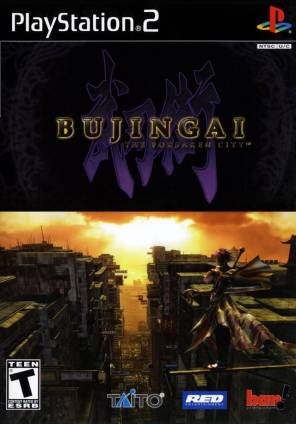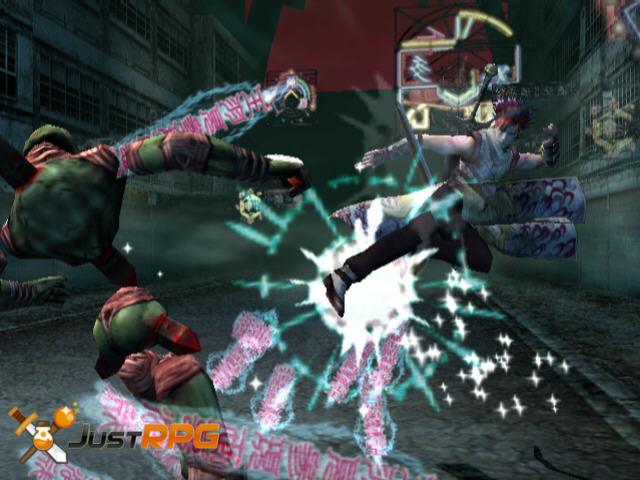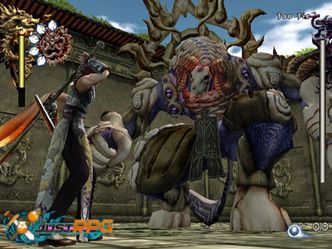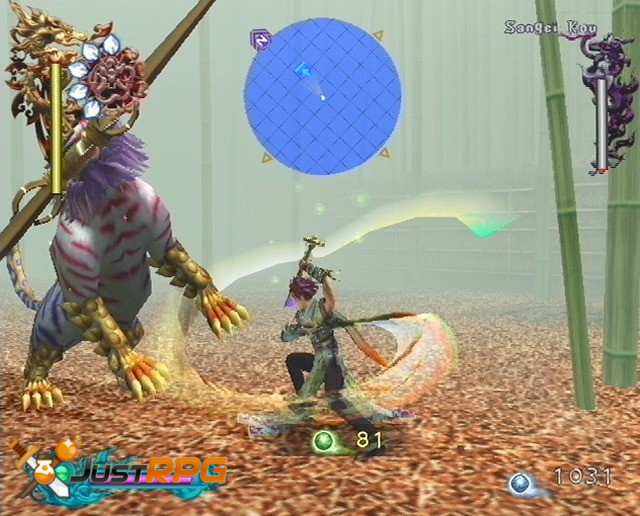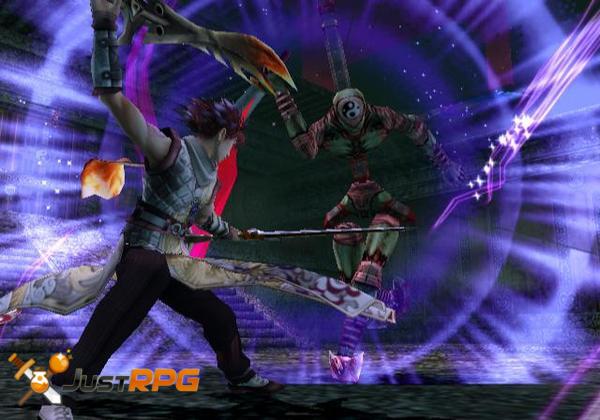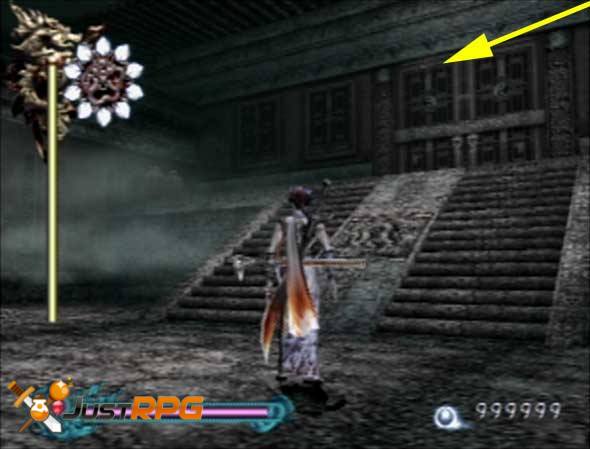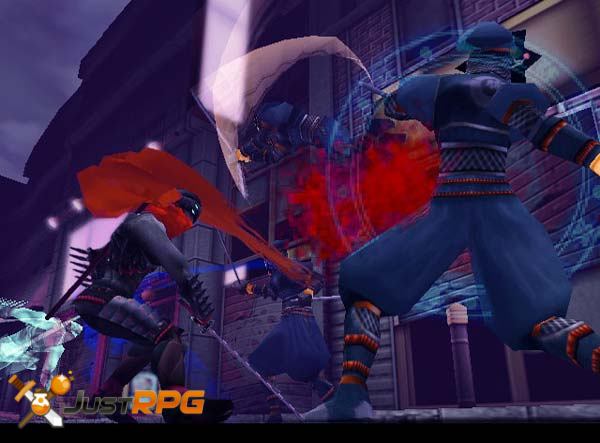Bunjingai: The Foresaken City is a hack-and-slash adventure game with some RPG elements. It also stars the famous Japanese recording artist, ‘Gackt’ as the basis of the main character/his voice.
Full Review
Bujingai: The Forsaken City Review
By, Jason Ferguson
Backdrop
.hack Part 1 Infection (Dot Hack) begins with a bang. Something disastrous happens to your character‘s real world friend, while innocently playing a 20 million-subscriber base, wildly popular online RPG game (MMORPG), The World. To unravel the mystery of your friend’s misfortune, you become an online, ingame rogue hacker, exploring every corner of The World, even some virus-infected ones.
The hero is armed with the special skills of Data Drain and Gate Hack, and some colorful, talented fellow adventurers to fill the two other available party slots. Different adventurers must accompany you depending on the plot‘s development. You have some control over the others in your party, including upgrading them through trades or gifts. You can play only a single class, Twin Blade. Other characters are from different classes, with varied strengths and weaknesses, from a mage type (Wavemaster) to a bully (Heavy Axeman).
Gameplay
Gameplay takes place in three principal areas – towns, fields, and dungeons. Towns house The World’s servers. There, the player can save the game, buy magic scrolls and useful and unique items, store items, buy equipment, and talk and trade with lots of other players in character online. One town has an unusual ranch to check out, a patent homage to an enduring feature of just about every Final Fantasy.
The town’s Chaos Gate provides instant teleportation to a particular wide-open Field, containing monster encounter hotspots, a mystical spring, treasure, and lots of mysterious food. You enter three distinct keywords, some known at the game‘s onset, and others learned through play. Whatever keywords are entered, the difficulty level of the destination is helpfully revealed. This prevents a low-level party from being massacred. Once the keywords are entered, you travel through the Chaos Gate. (You can enter specific keywords learned to continue the plot, do side quests, or do unlimited exploring. Or, you can instruct the Gate to enter random keywords, and take your chances. There‘s also an option to enter any keywords you wish from a word list.) Every Field houses a single Dungeon. The dungeons, where you spend much of the game fighting for your life, are not overly large in size, and always range between three and five average levels.
Many have compared Dot Hack to Phantasy Star Online Episode I and II (PSO) on the Gamecube. Let us gently discredit this. We feel Dot Hack has far better graphics than PSO. The Fields and Dungeons contain many colorful, over stylized backdrops and settings, including weather effects. Dot Hack’s monsters resemble the beautifully-drawn monsters of the later Final Fantasy’s. Dot Hack’s world is gigantic with a seeming infinite number of locations to explore. PSO’s world is relatively small, and plot is threadbare, with meaningless, though fun, side quests, which instill no enthusiasm in the player. Dot Hack’s plot is deep and complex, with each subplot advancing the story just a little bit further. (Remember though, the end of this game in no way comes close to wrapping up the story, to be completed in the three games to be released later this year.) One visual treat, however, was lifted directly from PSO – the cascading rings that accompany the teleportation of characters to and from different areas.
Combat
Dot Hack’s combat engine can best be described as modified real-time. Much like the action-RPG, Kingdom Hearts, button mashing can be effective to beat monsters. Monster combat icons appear as large yellow twirling landmarks. As you approach, the landmark dissolves, monsters come at you big-time, and, undoubtedly, players will feel a healthy adrenaline rush. Some of Dot Hack’s many monsters do not stand around waiting to be pummeled, rather some you need to catch. Dot Hack lets you turn combat almost into a turn-based affair. The player needs only to hit Triangle in the middle of battle to pause the game instantly. From there the player can give orders to the others in the party, anything from healing someone, reviving another, casting a spell, designating a target monster. Without jeopardizing your party from the hailstorm of monster blows, combat becomes a calmer, more strategic, experience. This will help the many action-challenged. Camera angles play a big role in successful combat. You must be facing a monster to do any damage. As in many games, manipulating opposing environmental elements, like fire vs. water, is a key to successful monster combat.
Dot Hack’s cyberspace setting provides a wealth of Wow-inducing outbursts. The Data Drain option in combat is a great example. When a monster’s approaches zero, the player can Data Drain to reduce a horrendous, gigantic steel robot, for example, into a sniveling, puny monster, easily defeated with a single blow. Data Drain always results in a nifty, rare item or essential Virus Cores so you can Gate Hack areas of The World now closed, but needing investigation. One bad side effect – if you defeat, a Data Drained monster, but a single experience point is earned. One REALLY bad side effect – if you Data Drain too often without giving the skill a rest, you may overload and explode. Game Over. In the case of Boss monsters, Data Drain works the same, but what remains is no sniveling puny monster, but a full-blooded slightly less tough monster. All of this makes for interesting and captivating combat, a large part of the game.
Fresh Features
Dot Hack is replete with new and interesting features that kept us riveted.
To start, the entire background and story of a real world gamer becoming a rascal hacker, penetrating deep into a virus-infected online game, is quite novel. Combine this with Dot Hack’s emulating the look and feel of an online game universe. (Message traffic on the web shows many gamers mistakenly believe Dot Hack is a real online MMORPG, along with monthly fees! No real Internet connection is required.)
Just like in the real word, Dot Hack replicates your excitement level when “New” appears before a popular forum or on your email screen. Some of the game involves receiving emails as the plot develops, as well as new, crucial information surfacing on The World’s Board. (Look out for emails challenging you to a strange game of Tag.) The online game world looks very familiar with a bunch of characters wandering around the game’s towns, with the ubiquitous balloon icons talking typical “trash” to each other, even criticizing “newbies“.
Combat grippingly called for surprisingly strategic decision-making to succeed, not related to the usual attack or defend choices. Do you go for experience and upgrade your character or try for some special equipment or a Virus Core, vital to Gate Hacking? The innovative control of other party members became second nature to us after some practice. The game rewards a player taking chances, like entering a Field or Dungeon rated 5 levels above the player’s current level. On the other hand, the game scoffed at players entering areas much lower rated the their current level, by awarding negligible experience points for victory.
Dot Hack takes progress reports to a new level, by slowly unlocking books that contain much in the way of statistics and information. There’s even a monster compendium with tips for defeating them.
Some might complain about the minimal “Save Game” ability, but we thrived on it. You explore a very hostile cyberspace environment without the facility to save. Only in a server-hosting town is saving possible at the local Recorder. We may be a solitary voice in the Wilderness, but we like this throwback to the good old RPG days. Those of you old enough to remember the Wizardry series, may recall those fingernail-biting multi-combat treks back to the Castle just to save the game. In case you’re really stuck deep in a dungeon, a common item will teleport you to the outdoor field, from where you can simply gate back to town from the command menu.
Many pieces of equipment come with distinctive powerful attack, healing, and status skills, essential to combat dominance. The player must tradeoff whether to equip something that will raise defense or offense or something less vigorous that lets you use a powerful skill. Trading is the most successful way to upgrade equipment.
In a first, Dot Hack comes with a 45 minute anime video. This gives some great background on what’s going on in The World, as well as provide clues for completing the game. In a nice twist, voiceovers for game speech can be set for Japanese or English presentation. Listening to the authentic Japanese voices really keeps you glued to the game.
Though some may scoff at what follows as meaningless, we liked the game’s unlocking of some nifty new “toys” to like, some only available when the game is cleared. You can unlock many different background music play lists. Tired of creepy tunes, just switch to something more upbeat, or futuristic. Just like real world gamers, who constantly change their desktop wallpaper, new and different wallpapers are unlocked along the way. Some are concept art of characters, while others are full blown anime renditions of the characters. This makes for great fun, and seems to pump additional energy into the game. As you progress over a dozen special cut scenes or movies will become viewable after defeating the game.
Though Dot Hack’s extras and new wrinkles enhance the RPG game experience, much of the gameplay will ring true to those who enjoy RPG‘s. Expect plenty of exploration in a huge 3D world, frequent monster combat, tons of treasure to earn and discover, upgrading your character’s weapons and armor, and needing to level before tackling pivotal story dungeons. The status screens for the characters and all equipment are well laid out and easy to grasp.
Time for Completion
Game length in hours always concerns many purchasers. A short RPG normally takes a lot of flack, and many online are asking about Dot Hack‘s time for completion. (Some have questioned whether Bandai should have released a single 80 hour game for $50, rather than four 20-hour games for $200 for a single story. This matter is beyond the scope of this review, but our high opinion of this game as a standalone is obvious.) Our experience, playing the plot without doing side quests or extra exploration, is in the 12 to 15-hour range. Players side-questing and extensively exploring, aside from the main plot, can expect to spend 25 hours to complete the game. You can even continue to advance your character, after game completion, to get a jump start on Part 2 due in May. In the next game, your character can be imported from Part 1.
Furthermore, imagine trying to explore every nook and cranny of the fields and dungeons accessible by a large number of 3-word combinations. Doing that would put the game in the 50-hour range, if not more. However, at a certain point, new items dry up, and a single experience point is earned for any defeated monster, no matter how tough.
Shortcomings
While, as is evident above, there is much to recommend in Dot Hack, certain concerns to varying degrees deserve mention.
From the “Why oh why did they leave this out?“ File. Pregame game board traffic and information about the Japanese version released months ago had many salivating for replaying the game in “parody” mode. This mode apparently converted all Dot Hack’s game world characters into satirical comedians. Sorry to say, this highly-anticipated feature is missing from the version released here.
The game requires massive amounts of button pressing. Every item or treasure uncovered from combat victories or exploration (opening chests, searching expired adventure remains, collecting food for Grunty’s, as examples) must be confirmed with a button press. When there could be 50-100 such occurrences in a single dungeon or field, over the course of the game, finger cramps seem inevitable. Baldur’s Gate: Dark Alliance also required lots of bashing for buried treasure and chests, but the items literally flew into your inventory, a much better way to handle this.
The manual is woefully terse and lacking in some crucial information and guidance. While the ingame tutorials fill in many of the gaps, one extremely important gameplay feature is missing from both the manual and tutorials – instructions on control your characters directly during combat.
Final Word
We got a kick out of Dot Hack. The feeling of “just one more dungeon” dominated our lives for the 3 days to completion. The engaging environment held our attention without much effort. The strategic nature of combat, plus the convoluted plot kept us going for hours on end. The constant unlocking of both frivolous and important gameplay features created a “what’s next” anticipation. Now, if I could only read Japanese better, Dot Hack Part 2 is already out in Japan!
Final Grade: B
Bujingai: The Forsaken City is a fast paced action game with a lot of RPG elements from BAM! Entertainment. The game bares many striking similarities to Sega’s, Otogi: Myth of Demons. So does the game differentiate itself enough from other action games, like Otogi, to make it worth playing?
The story takes place in the distant future. A nuclear experiment gone wrong resulted in massive amounts of radiation bombarding the earth. Most humans were killed instantly, but the survivors found themselves imbued with supernatural abilities. Shortly after, fierce demons appeared and dominated the earth. For years the survivors honed their abilities, training with deadly fighting arts in order to fight off the demons.
You’ll play the game as Lau Wong, a great warrior. Years after his death, he descends from the heavens in order to stop the demons. Rei Jenron was once Lau’s best friend. The two trained side by side under the guidance of Master Tensai, and together they were a formidable foe against the demons. But now Rei has become a demon, and Lau must fight his old friend in order to save humanity!
Although the story is interesting enough, it’s not very well relayed throughout the game. Some of the story you’ll only get from the game manual, while other bits are explained in an opening cinematic that’s easy to accidentally skip over. The story doesn’t tie together very well, so you’ll probably find yourself with a lot of questions. Fortunately, the story isn’t overly deep or complex, so this lack of information doesn’t really keep you from being able to follow and enjoy the game. Still, the experience would certainly have been heightened by more solid storytelling.
Lau is modeled after Japanese star, Gackt. Fans of Gackt will definitely want to check the game out. Lau ends up looking quite a bit like a girl (actually, it’s hard to tell either way), but there’s an unlockable costume design where you can play as Gackt.
Bujingai is all about the action, which is fast and fierce. Gameplay is similar to that of Otogi. You hit Square to attacking, X to jump, triangle to do a spin attack, and circle to use magic. You can chain together your attacks allowing you to beat down your enemy before he even has the chance to strike back. Lau can perform all sorts of crazy acrobatics, like running straight up a wall, or gliding through the air. You can even battle in mid-air while slashing away at your enemy. Uppercut an enemy into the air and beat him with a frenzy of sword swipes, finishing him off with a blast of magic. Combat isn’t horribly deep, but it’s lots of fun, and usually ends of a splendor to look at. The crazy stunts and the fast paced action are reminiscent of something from Crouching Tiger Hidden Dragon. Needless to say, it’ll blow you away!
One important aspect of combat that separates Bujingai from most action games is the defense meter. The higher your defense meter the more attacks you’ll be able to block. Your defense gauge can be upgraded as the game progresses, allowing you to defend more and more attacks. You auto defend attacks of enemies who you are facing as long as your defense meter isn’t empty, so you can afford to take a few hits before you start taking damage. Enemies also have defense meters, and some of the tougher enemies have extremely high defense. Trying to attack them outright can be suicide, so you’ll have to think and look for the right moment to attack.
Lau can lock onto enemies, making it easier to keep track of them and battle them in midair. He can also counter spells, which reflect enemy magic back at them and refill your magic gauge. I found this a very interesting ability that can easily turn the tide of any battle. It adds a new dimension to the game that keeps it from being mindless hack and slash. Use of the environment is also very important, since you can run up a wall to escape from your enemy, or jump off the wall to land behind an enemy allowing you a clean shot with your sword. This all sounds pretty complex, but there’s an optional tutorial in the beginning that will thoroughly teach you the game’s mechanics.
Throughout the game Lau will acquire new magic spells. Each spell has different effects, like summoning a whirlwind or unleashing a volley of fireballs. You’ll also be able to find upgrades for your magic, which allow you to perform higher-level spells. When you defeat an enemy they drop blue orbs. These blue orbs serve as the games form of experience and can be exchanged between stages to upgrade your character. Your attack strength, magic strength, health bar, magic bar and defense are all upgradeable. You can customize Lau however you want him, which adds some strategy and depth to the game.
The controls can cause some problems from time to time. Because of the combo system, Lau continuously swings his sword as you push square, and backing out of a combo once it’s been started is nearly impossible. Often times you’ll find yourself falling of a ledge somewhere because Lau walks right off the edge as he swings his sword, or you’ll find yourself vulnerable to enemy attacks from behind as you complete a combo. Also, like most action titles, the camera can cause a few problems, especially during some of the games many jumping puzzles. The lock-on feature helps a lot, but poor camera angles are more than likely to kill you off a few times.
Graphically, the game is simply beautiful. The movements and animations are smooth and gorgeous. Playing the game will make you feel like you’re watching a Hong Kong action flick. The environments are large and detailed, with a good deal of variety. Much like Otogi, the game features destructible environments, but not nearly to the same extent as Otogi. You can break doors down, cut down trees and bash boxes. Not horribly deep, but fun. The character design is really nice, and the game features some highly detailed, interesting characters. Although Lau eerily looks like a girl, he’s still well designed, as are the games other characters. On the other hand, the enemy variety isn’t particularly large. Even the bosses repeat rather quickly. Still, the combat is good, so it doesn’t really matter who you’re fighting!
The music in the game is an interesting blend of Chinese music and heavy metal. It somehow manages to fit the game pretty well. The musical variety remains pretty solid, and won’t get too repetitive. The voice acting is solid, but nothing extraordinary. The characters mouths don’t move well along with the words, but the voices that come out still fit each character well and do a pretty good job. The effects, like slashing of swords, are done pretty well and help to bring the action to life.
The game is pretty short, and can be easily beat in 10 hours. Action/RPG fans that are looking for 30+ hours out of their games may be a bit disappointed. Still, there are plenty of reasons to go back into the game and replay. There are hordes of unlockables, including different outfits for Lau, an interview with Gackt, a character viewer, and more! The game offers a very high level of challenge, so you may be struggling from time to time. Fortunately, there are two different difficulty settings, so you can try your hand at the easy mode before trying the hard. Playing through hard mode shouldn’t be too frustrating, though, because the game offers an unlimited number of continues. A neat replay Bujingai features is the option to create a custom opening cinematic. It’s pretty simplistic, but you can watch yourself control Lau against an army of baddies in your own cinematic.
Bujingai: The Forsaken City ends up being a very good action title. It’s a bit on the short side, and the story wasn’t very well implemented, but the beautiful graphics, RPG depth and non-stop action more than make up for it. If you like action games, like Otogi: Myth of Demons, you’ll definitely like Bujingai.
Final Verdict: 75%

